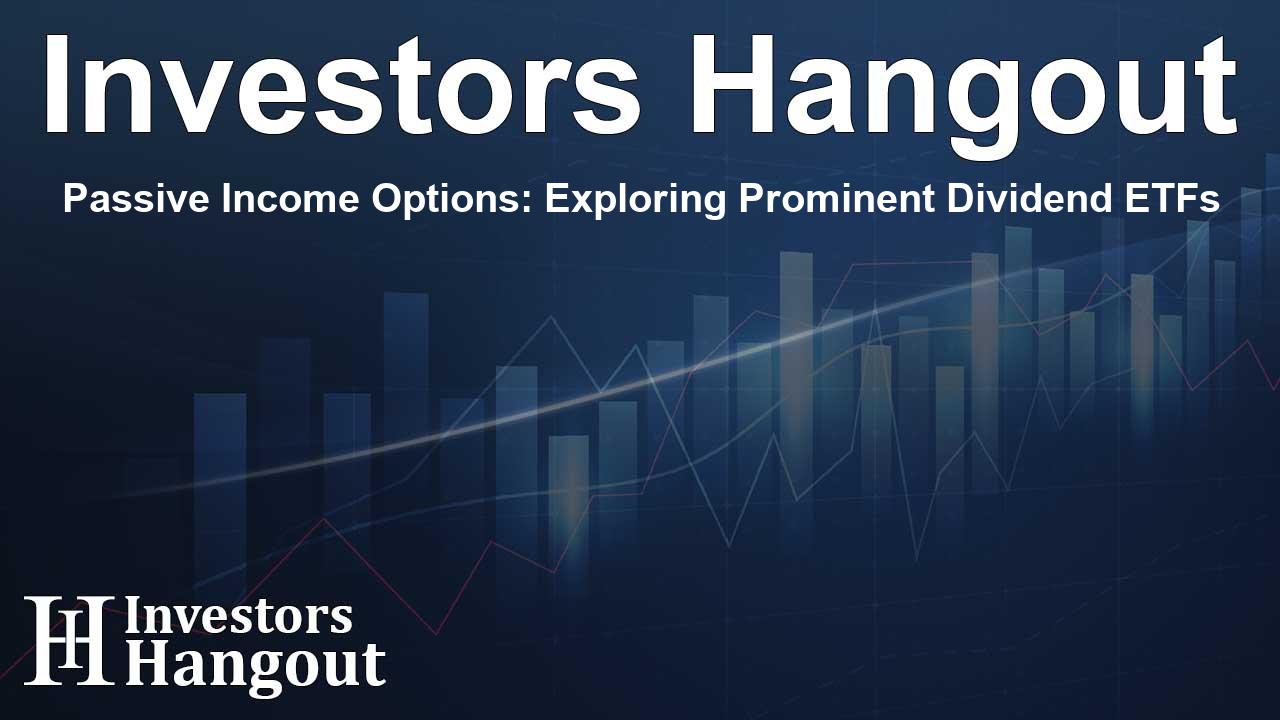Passive Income Options: Exploring Prominent Dividend ETFs

Introduction to Passive Income Through Dividend Stocks
Investing in dividend-paying stocks is an insightful way to earn passive income. The responsibility lies primarily in selecting which stocks to invest in and managing your portfolio effectively.
One of the best passive investment methods is to purchase an exchange-traded fund (ETF) specifically focused on dividends. Such funds offer a robust strategy for enhancing passive income within your portfolio.
Top Dividend Stocks in a Consolidated Fund
The Schwab U.S. Dividend Equity ETF (NYSEMKT: SCHD) simplifies the investment in dividend stocks. It follows the Dow Jones U.S. Dividend 100 index, which selects high-yield stocks that have a track record of consistent dividend payments. Moreover, these companies typically exhibit stronger financial metrics compared to their counterparts. As such, this fund encompasses around 100 of the leading dividend-paying companies nationally.
The leading holdings in this ETF currently include:
Lockheed Martin, known for its 2.2% dividend yield, has consistently raised its dividend for 21 years.
AbbVie offers a rich 3.2% yield and boasts over a quarter-century of annual dividend increases.
- Home Depot has a current yield of 2.4% and has increased its payout for 15 consecutive years.
- Blackrock, delivering a 2.3% yield and sustained dividend growth for 15 years.
- Coca-Cola with a solid dividend yield of 2.7%, holding the record of 62 years of consistent increases.
The fund's ten largest holdings constitute approximately 40% of its overall value, implying a significant weight on premier dividend stocks. Over the past year, the Schwab U.S. Dividend Equity ETF has provided an impressive dividend yield of 3.4%, well above the S&P 500's average yield of under 1.5%. With a remarkably low expense ratio of only 0.06%, this ETF stands out as a favorable option for generating passive income.
Concentration on High-Yield Dividend Stocks
Another compelling option is the SPDR Portfolio S&P 500 High Dividend ETF (NYSEMKT: SPYD). This fund targets the 80 highest-yielding stocks within the S&P 500, emphasizing yield to generate superior dividend income per dollar invested. Currently, it boasts a yield exceeding 4%.
The SPYD ETF maintains an equitable allocation among its 80 holdings, which helps mitigate risks associated with individual stocks. Its top contributors are:
Kellanova (2.9% yield)
Kenvue (3.6% yield)
Public Storage (3.3% yield)
Ventas (2.8% yield)
Regency Centers (3.6% yield)
This ETF adopts a broader risk strategy focusing on yield over quality. However, this can lead to higher risk regarding potential dividend reductions if the companies encounter financial difficulties. In exchange, the higher yield compensates for this risk and the fund’s ultra-low expense ratio of 0.07% allows investors to retain a larger share of their earnings.
Effective Strategies for Passive Income Generation
ETFs are inherently passive investments, making them perfect candidates for generating passive income streams. Both the Schwab U.S. Dividend Equity ETF and the SPDR Portfolio S&P 500 High Dividend ETF provide unique advantages. The former offers access to high-quality dividend stocks, while the latter concentrates on yield, ensuring that investors can enjoy the benefits of passive income flow into their accounts.
Evaluating Your Investment Options
Investors should carefully consider their approach before investing in the Schwab U.S. Dividend Equity ETF. Understanding the current market trends and aligning them with personal financial goals is essential.
While these investment options have their strengths, conducting proper due diligence will ensure optimal selections aligned with your investment strategy.
Frequently Asked Questions
What is a dividend ETF?
A dividend ETF is an investment fund that holds a collection of dividend-paying stocks, providing investors with exposure to these shares and regular income from dividends.
How does the Schwab U.S. Dividend Equity ETF perform compared to the S&P 500?
The Schwab U.S. Dividend Equity ETF typically offers a much higher yield than the S&P 500, making it a more attractive option for income-focused investors.
What are the risks associated with high-yield dividend ETFs?
High-yield dividend ETFs may face risks such as financial instability in their holding companies, leading to potential dividend cuts or reduced capital value.
Can dividend ETFs provide passive income?
Yes, dividend ETFs are considered excellent options for passive income generation since they pay out regular dividends to investors based on their holdings.
What should I consider before investing in a dividend ETF?
Before investing, evaluate the expense ratios, dividend yields, historical performance, and underlying holdings of the ETF to ensure it aligns with your financial objectives.
About The Author
Contact Addison Perry privately here. Or send an email with ATTN: Addison Perry as the subject to contact@investorshangout.com.
About Investors Hangout
Investors Hangout is a leading online stock forum for financial discussion and learning, offering a wide range of free tools and resources. It draws in traders of all levels, who exchange market knowledge, investigate trading tactics, and keep an eye on industry developments in real time. Featuring financial articles, stock message boards, quotes, charts, company profiles, and live news updates. Through cooperative learning and a wealth of informational resources, it helps users from novices creating their first portfolios to experts honing their techniques. Join Investors Hangout today: https://investorshangout.com/
The content of this article is based on factual, publicly available information and does not represent legal, financial, or investment advice. Investors Hangout does not offer financial advice, and the author is not a licensed financial advisor. Consult a qualified advisor before making any financial or investment decisions based on this article. This article should not be considered advice to purchase, sell, or hold any securities or other investments. If any of the material provided here is inaccurate, please contact us for corrections.
